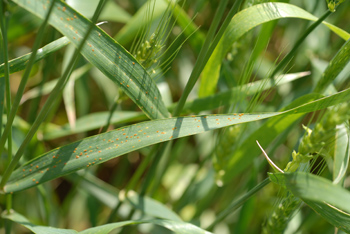
Agricultural News
Bob Hunger Finds Cool, Wet Weather Creates Variable Maturity Wheat, Leaf and Stripe Rust
Fri, 29 May 2015 11:57:20 CDT
 Dr. Bob Hunger has released his latest wheat disease report for Oklahoma- as well as providing what he is hearing from other states as well. Dr. Hunger is Extension Wheat Pathologist at Oklahoma State University.
Dr. Bob Hunger has released his latest wheat disease report for Oklahoma- as well as providing what he is hearing from other states as well. Dr. Hunger is Extension Wheat Pathologist at Oklahoma State University.
Oklahoma: Dr. Jeff Edwards (Small Grains Extension Agronomist) and I spent Tuesday and Wednesday in the OK panhandle at variety trial field days located near Keyes (Cimarron County), Balko, and Hooker (both in Texas County). A significant number of wheat fields were in a condition I have not seen before (at least not to this extent). These fields had small islands of wheat that was at milk (approaching soft dough) surrounded by large areas of greener tillers that ranged from just prior to flowering to initiation of kernel formation. This condition resulted from the drought during this past fall, winter, and early spring, which lasted until mid-April followed by the cool and wet weather since mid-April. Much of the wheat in these fields was shut down by the drought but there also were isolated pockets of wheat that more or less made it through the drought. As cool temperatures and moisture became prominent in mid-April, the areas hit hard by drought recovered and sent up secondary tillers that are now green and less mature than the "islands" of wheat that made it through the drought. Hence there is 2-3 weeks difference in maturity between different areas within the same field. In some fields there are only a few "islands" of secondary wheat, but in other fields the secondary wheat predominates with only "islands" of more mature wheat. How this will play out over the next month will have a great deal to do with the weather. Dr. Edwards feels that if cool weather continues, the secondary tillers stand a chance of making wheat. However, if hot (>90 F), dry and windy weather enters the picture, the secondary tillers likely will not finish.
As in down-state in Oklahoma, stripe rust was prevalent at all locations with leaf rust present on varieties such as Greer and Jackpot that have excellent stripe rust resistance but are susceptible to leaf rust.
Damage from wheat streak mosaic (WSM) also was evident, but in the fields where the variety trials were located incidence was low and damage minimal. However, from samples we have continued to receive from the panhandle there must also be fields that have been significantly impacted by WSM.
We also visited one field (an irrigated circle) where we thought black chaff may be involved, but this appears to be more a case of physiological leaf spotting than bacteria. Isolation and testing are being started today. Other samples received from north-central OK last week where black chaff is suspected to be involved are still being evaluated. However, as indicated last week head darkening is definitely more common down-state than it is in the panhandle.
Reports/excerpts of reports from other states:
Nebraska: Dr. Stephen Wegulo (Extension Plant Pathologist); University of Nebraska; 28-May-2015: “Yesterday I looked at wheat fields in southern Nebraska along the Highway 4 corridor (about 20 miles north of the Kansas border) from southeast to southwest. Incidence of stripe rust was 100% in all fields that were not sprayed and severity was very high in fields with susceptible varieties (>75% and close to 100% in a couple of fields I looked at - that is, the entire foliage in the whole field, not just some leaves). Many fields looked spectacularly yellow due to stripe rust. Weather conditions continue to be favorable to the disease. Growth stage ranged from flowering to beginning of ripening. Other diseases were completely overshadowed by stripe rust. I saw one head with Fusarium head blight in a state variety trial in the southeast.”
WebReadyTM Powered by WireReady® NSI
Top Agricultural News
More Headlines...




















